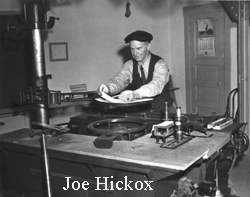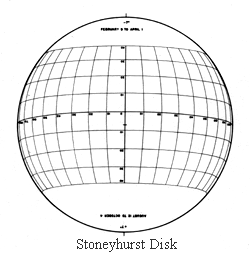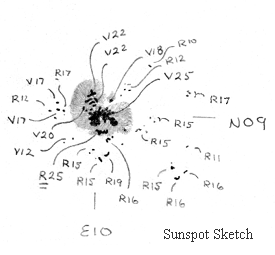
Sunspot Drawing
 |
The 150-Foot Solar Tower Sunspot Drawing |
The daily (synoptic) sunspot drawings done at the 150-Foot Solar tower were begun on January 4, 1917. Prior to this date, sunspot sketches were often made by the observers, but it was not until a parallel-plate micrometer was built to visually measure sunspot magnetic field strengths that solar drawings became part of the regular observing routine. All of these drawings have been archived, and as of 2007 there are over 27,000 on file.

The early observers never intended that these sunspot drawings be an exact reproduction of spot conditions found on the solar disk. In fact, many of the early drawings were rather crude, lacking the detail found in modern drawings. For the first few years, the drawings were considered only to be a general outline serving as a map to show which spots correspond to the magnetic measurements, and as a reference for additional photographic studies. However, over time a sense of pride developed among the observers, so eventually the drawings evolved into the highly detailed and accurate diagrams seen today, sometimes requiring hours to complete.
The sunspot drawing is done in pencil, on a 25.5 by 50 cm pad of white acid-free paper. Solar north is at the top of the paper, and solar east is to the right-hand side. To do a drawing, the observer must first orient the drawing table (located on top of the spectrograph head within the focal plane of the telescope) so that its x-axis is parallel to the Earth's equator as projected onto the sun. Then a correction can be made to this angle so the edges of the sketch pad will match the North/South - East/West heliocentric coordinates of the sun. This is begun by first aligning the North or South limb of the sun next to a straightedge of the table, then running the telescope drive in its east or west direction. This is equivalent to turning off the telescope drive and letting the image "drift" along the earth's equator as projected onto the sky; hence the term "solar drift angle." A known correction (the solar P-angle) is then applied to this drift angle to bring the table around to the proper orientation, ensuring that the top edge of the sketch pad runs perpendicular to the sun's axis of rotation. These angles are always recorded in the lower left-hand corner of the archived drawing, but not always included on the website gif image.

Next, a Stonyhurst disk and its holder are placed on alignment holes recessed into the drawing table to keep the holder square to the edges of the table. The Stonyhurst disk is a circular piece of cardboard drawn to the same diameter as the solar image and equipped with lines of solar latitude and longitude to be used as a reference for sunspot positions. Eighteen different Stonyhurst disks are used throughout the year to accommodate varying solar B-angles and earth orbital distances from the sun.
Since the plane of the Stonyhurst is also near the focal plane of the telescope, sunspots will be projected onto the disk, and their heliocentric positions can be easily read and recorded. Note that for sunspot groups, the location recorded is an eye estimate of the area-weighted position. At the scale of the image (average diameter being about 42 cm) spot positions can be easily determined to one-half a solar degree, although the positions recorded on the drawing are usually rounded to the nearest integer degree.
After the spot positions are recorded, the Stonyhurst disk is removed, and the solar image is now projected directly onto the sketch pad. The edges of the pad are clamped down to the table to prevent movement, and the sunspots are traced directly onto the white paper. The detail laid down is highly dependent upon seeing conditions as well as the skill or interest of the observer at the time, so understandably it varies a little with each observation. Usually, the hardest thing for the observer to determine is what constitutes a real sunspot or pore, and what is just a "faint mark" originating from dark intergranular lanes. This particular point is highly seeing-dependent, so when in doubt, the observer will mark a spot as "fm."
Observers usually mark each umbra (or lone spots) using a soft No. 1 pencil, then outline the penumbras using a hard No. 9, filling them in later. Evidence of fibrils which may be seen within any given penumbra are usually not real and stem from the artistic imagination of the observer.
Sunspot positions, the limb and its fiducial marks, and all other labeling are done using a No. 5 pencil. The official UT time of the drawing is usually noted at this point, but if an interruption occurs between the marking of the spots and the measurement of the polarities, a note will be made in the drawing comment.
After the spot positions have been carefully laid down and their positions added to the paper, the observer removes the table and readies the spectrograph for measuring the individual spot field strengths and polarities. The spectrograph head is turned to the zero position so that the entrance slit is now parallel to the ruled lines of the diffraction grating in the spectrograph pit. A green interference filter is placed over the entrance slit to isolate the 5250.216 Å line of iron used for the magnetic determinations. The polarizing equipment and techniques involved to determine actual field strengths and polarities has been adequately described elsewhere, and is beyond the scope of this discussion. But in practice, the observer uses a visual parallel-plate micrometer (also known as the "tipping plate") to determine polarities and fields strengths by directly measuring the Zeeman splitting of the 5250 line. The spot to be measured is placed above the entrance slit, and the observer judges its polarity and field strength using the tipping plate which is placed at the focal plane of the 75-foot spectrograph. In this manner, sunspot polarities and field strengths can be obtained with an accuracy down to a few hundred gauss. For scientific purposes, all spot groups are labeled with a Mt. Wilson sunspot group number and magnetic classification, but this is done at a later date and is not seen on the daily web image.
The figure to the left shows a typical sunspot sketch. The coordinates N09 and E10 represent units of heliographic degrees north or south of the solar equator and east or west of the sun's central meridian. The magnetic field values V22, R15, etc., attached by lines to their respective spots or umbrae, represent the spot's polarity and its field strength in gauss divided by 100. This odd designation of R and V began with Hale and Nicholson and originated from the idea that with a certain orientation of the analyzing optics, the spectral line is seen to split either to the red or violet end of the solar spectrum. In modern terms, an R means the polarity is of a north or positive field, and a V stands for a south or negative field. So, as an example, R22 means a spot of positive (north) polarity with a field of 2,200 gauss. Values with an added single underline indicate that the observer realizes the spot or spot value seems magnetically out of place, so it has been double checked and verified. Double underlined values mean that the spot is of the delta configuration: two spots of opposite polarity lying within the same penumbra and within 2 degrees of one another.
Spots or groups very close to the limb are often hard to measure due to the inclination of the magnetic lines of force, so if there is any doubt about the measurement, or if it is indeed not possible to obtain a measurement, a question mark or an X will be substituted for a value.
After all the visible spots have been measured the observer will rate the average seeing value over the course of the drawing. The Mt. Wilson seeing scale is from 1 to 5 and is explained in the table below.
2 = Solar image is always fuzzy and out of focus. No sharp periods. Limb motion and resolution in the 5 to 10 arcsec range.
3 = Solar image about half the time sharp and half the time fuzzy. Some short periods where granulation is visible. Limb motion and resolution in the 3 arcsec range.
4 = Solar image more often sharp than not. Granulation almost always visible. Limb motion and resolution in the 1 to 2 arcsec range.
5 = Solar image looks like an "engraving." Extremely sharp and steady. Limb motion and resolution 1 arcsec or better.

Mt. Wilson Solar Seeing Scale:
1 = Solar image looks like a "Circular Saw Blade." Completely out of focus. Limb motion and resolution greater than 10 arcsec. Smaller sunspots will not be seen.
Note: Observers may use fractional values if the image quality falls between any of the above definitions.
Go to Current Sunspot Drawing
Page content and all images © 2003 The Regents of the University of California. All rights reserved.
Return to 150-Foot Solar Tower Home Page
Article by Larry Webster